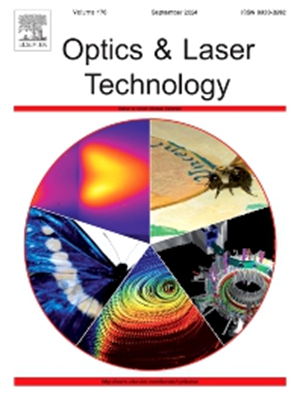Fabrication of sapphire optical windows with infrared transmittance enhancement and visible transmittance reduction by femtosecond laser direct writing
IF 4.6
2区 物理与天体物理
Q1 OPTICS
引用次数: 0
Abstract
Enhancing the infrared transmittance of the sapphire windows is an effective approach to improving the infrared detection quality. Herein, the maskless fabrication of anti-reflection subwavelength structures through femtosecond laser direct writing was reported. The sapphire windows with micro-column arrays with different key parameters were simulated through the finite-difference time-domain (FDTD) theory to study the relationship between the structural parameters and optical properties. The calculation and simulation results provide the theoretical basis for devising anti-reflection subwavelength structures. The effects of different polarization states on the morphology and optical properties of micro-column arrays were investigated. The anti-reflection subwavelength structures with a period of 2 μm fabricated by circularly polarized femtosecond laser reached a maximum transmittance of 90.63% at the wavelength of 3.5 μm, while the visible light can be partly filtered. In addition, the contact angle of the sapphire window also increases from 77.48° to 126.42° after the fabrication of anti-reflection subwavelength structures, which is very fit for infrared detection as infrared optical windows. Our study demonstrates the possibility of achieving infrared anti-reflection and visible transmittance reduction by femtosecond laser direct writing, which can also be extended to other superhard windows.
飞秒激光直写制备红外增强、可见光降低的蓝宝石光学窗
提高蓝宝石玻璃的红外透过率是提高红外探测质量的有效途径。本文报道了利用飞秒激光直写技术制备抗反射亚波长结构的无掩模方法。利用时域有限差分(FDTD)理论对具有不同关键参数的微柱阵列蓝宝石窗口进行了仿真,研究了结构参数与光学性能的关系。计算和仿真结果为设计抗反射亚波长结构提供了理论依据。研究了不同偏振态对微柱阵列形貌和光学性能的影响。圆偏振飞秒激光器制备的周期为2 μm的抗反射亚波长结构在3.5 μm波长处的透过率达到90.63%,可见光可以部分滤除。此外,在制作增反射亚波长结构后,蓝宝石窗口的接触角也从77.48°增加到126.42°,非常适合作为红外光学窗口进行红外探测。我们的研究证明了飞秒激光直接写入实现红外抗反射和可见光透射率降低的可能性,这也可以推广到其他超硬窗口。
本文章由计算机程序翻译,如有差异,请以英文原文为准。
求助全文
约1分钟内获得全文
求助全文
来源期刊
CiteScore
8.50
自引率
10.00%
发文量
1060
审稿时长
3.4 months
期刊介绍:
Optics & Laser Technology aims to provide a vehicle for the publication of a broad range of high quality research and review papers in those fields of scientific and engineering research appertaining to the development and application of the technology of optics and lasers. Papers describing original work in these areas are submitted to rigorous refereeing prior to acceptance for publication.
The scope of Optics & Laser Technology encompasses, but is not restricted to, the following areas:
•development in all types of lasers
•developments in optoelectronic devices and photonics
•developments in new photonics and optical concepts
•developments in conventional optics, optical instruments and components
•techniques of optical metrology, including interferometry and optical fibre sensors
•LIDAR and other non-contact optical measurement techniques, including optical methods in heat and fluid flow
•applications of lasers to materials processing, optical NDT display (including holography) and optical communication
•research and development in the field of laser safety including studies of hazards resulting from the applications of lasers (laser safety, hazards of laser fume)
•developments in optical computing and optical information processing
•developments in new optical materials
•developments in new optical characterization methods and techniques
•developments in quantum optics
•developments in light assisted micro and nanofabrication methods and techniques
•developments in nanophotonics and biophotonics
•developments in imaging processing and systems

 求助内容:
求助内容: 应助结果提醒方式:
应助结果提醒方式:


